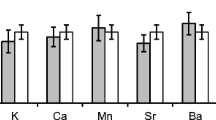Abstract
Ethambutol is an oral anti-tuberculosis agent with chelating effects owing to its chemical structure which is similar to that of penicillamine. Copper (Cu) is an essential trace element that has important roles in physiological function of the body organs. The aim of present study was to determine (1) whether ethambutol usage can alter serum Cu concentration in patients with tuberculosis and (2) whether there is any relationship between age, sex, and smoking habit of patients with changes in serum Cu levels. Sixty patients with diagnosis of pulmonary tuberculosis were enrolled the study. Blood samples were obtained before treatment (baseline) and 10 days after starting anti-tuberculosis therapy. The amounts of serum Cu were determined in all samples by atomic absorption. Mean ± SD levels of Cu at baseline and on the 10th day of ethambutol use were 0.94 ± 0.24 and 0.64 ± 0.24 μg/mL, respectively. Statistical analysis confirmed a significant difference (p < 0.0001). Also, there was not any relationship between changes in Cu concentration and study variables of age, sex, and smoking habit. Our findings endorse the chelating effect of ethambutol leading to a decrease in serum levels of cationic trace elements, e.g., Cu.



Similar content being viewed by others
References
Olivares M, Uauy R (1996) Cu as an essential nutrient. Am J Clin Nutr 63(5):791s–796s
Bonham M, O’Connor JM, Hannigan BM, Strain JJ (2002) The immune system as a physiological indicator of marginal Cu status? Br J Nutr 87(5):393–40
Wintergerst ES, Maggini S, Hornig DH (2007) Contribution of selected vitamins and trace elements to immune function. Ann Nutr Metab 51(4):301–323
Brewer GJ (2000) Recognition, diagnosis and management of Wilson’s disease. Proc Soc Exp Biol Med 223(1):39–46
Lacy CF, Armstrong LL, Goldman MP, Lance LL (2005) Drug information handbook, 13th edn. Lexi-Comp, Hudson, pp 1166–1168
Storla DG, Yimer S, Bjune GA (2008) A systematic review of delay in the diagnosis and treatment of tuberculosis. BMC Public Health 14(8):15
Small PM, Fujiwara PI (2001) Management of tuberculosis in the United States. N Engl J Med 345(3):189–200
Solecki TJ, Aviv A, Bogden JD (1984) Effect of a chelating drug on balance and tissue distribution of four essential metals. Toxicology 31(3–4):207–216
Bogden JD, Lintz DI, Joselow MM, Charles J, Salaki JS (1977) Effect of pulmonary tuberculosis on blood concentration of Cu and zinc. Am J Clin Pathol 67(3):251–256
Liu X, Ding L, Wang Y, Yang Y (2000) Determination of trace elements in serum of tuberculosis patients. Wei Sheng Yan Jiu 29(6):395–396
Ciftci TU, Ciftci B, Yis O, Guney Y, Bilghan A, Ogretensoy M (2003) Changes in serum selenium, Cu, zinc levels and Cu/Zn ratio in patients with pulmonary tuberculosis during therapy. Biol Trace Elem Res 95(1):65–71
Mohan G, Kulshreshtha S, Sharma P (2006) Zinc and Cu in Indian patients of tuberculosis: impact on antitubercular therapy. Biol Trace Elem Res 111(1–3):63–69
Khanna BK, Kumar R, Mukerji PK, Chowdhury AR, Kamboj VP (1982) Plasma copper and zinc levels in pulmonary tuberculosis. Indian J Tuberc 29(3):179–184
Benes B, Spevácková V, Smíd J, Batáriová A, Cejchanová M, Zítková L (2005) Effects of age, BMI, smoking and contraception on levels of Cu, Se and Zn in the blood of the population in the Czech Republic. Cent Eur J Public Health 13(4):202–207
Milne DB, Johnson PE (1993) Assessment of Cu status: effect of age and gender on reference ranges in healthy adults. Clin Chem 39(5):883–887
Suliburska J, Duda G, Krejpcio Z (2007) Influence of smoking on selected microelements in serum and hair of adult. Przegl Lek 64(10):710–712
Pelton R, LaValle J, Hawkins EB, Krinsky DL (2001) Drug induced nutrient depletion, 2nd edn. Lexi-Comp, Hudson
Author information
Authors and Affiliations
Corresponding author
Rights and permissions
About this article
Cite this article
Abbasi Nazari, M., Kobarfard, F., Tabarsi, P. et al. Serum Copper (Cu) Alterations in Pulmonary Tuberculosis Patients Under Treatment with Ethambutol. Biol Trace Elem Res 128, 161–166 (2009). https://doi.org/10.1007/s12011-008-8267-8
Received:
Accepted:
Published:
Issue Date:
DOI: https://doi.org/10.1007/s12011-008-8267-8




